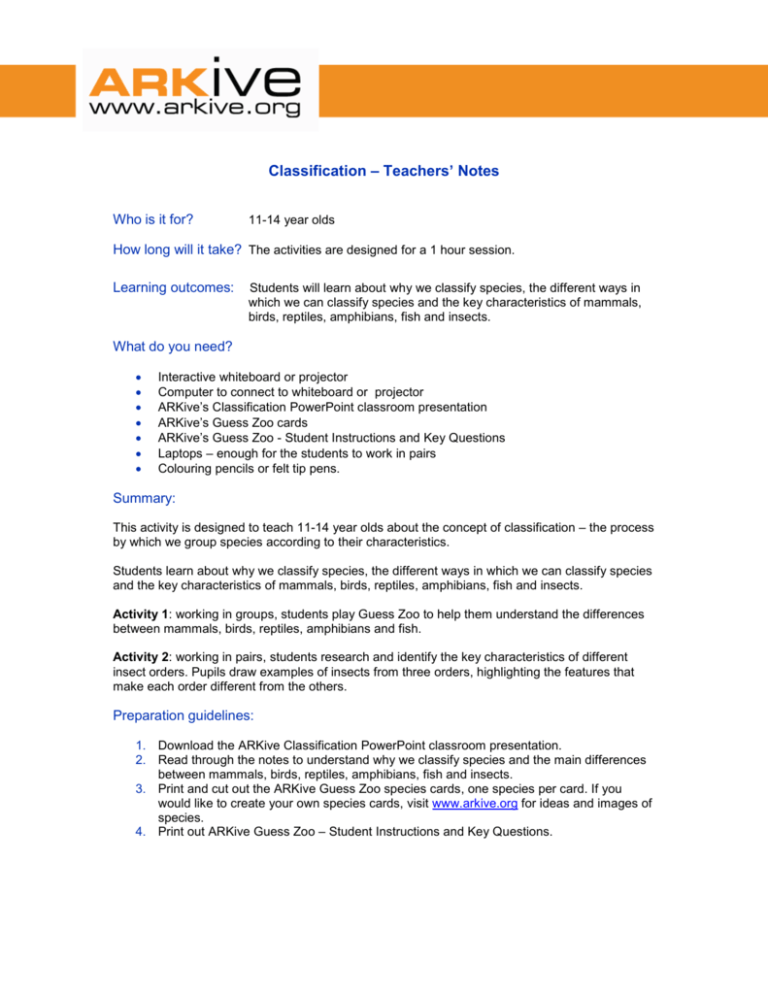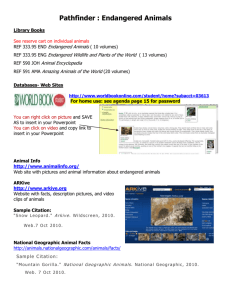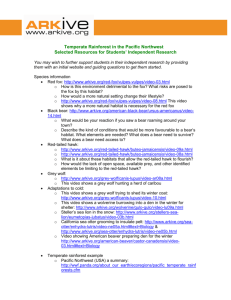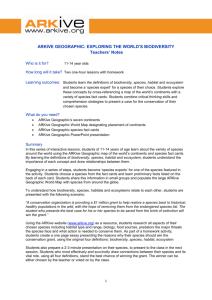Teachers` Notes
advertisement

Classification – Teachers’ Notes Who is it for? 11-14 year olds How long will it take? The activities are designed for a 1 hour session. Learning outcomes: Students will learn about why we classify species, the different ways in which we can classify species and the key characteristics of mammals, birds, reptiles, amphibians, fish and insects. What do you need? Interactive whiteboard or projector Computer to connect to whiteboard or projector ARKive’s Classification PowerPoint classroom presentation ARKive’s Guess Zoo cards ARKive’s Guess Zoo - Student Instructions and Key Questions Laptops – enough for the students to work in pairs Colouring pencils or felt tip pens. Summary: This activity is designed to teach 11-14 year olds about the concept of classification – the process by which we group species according to their characteristics. Students learn about why we classify species, the different ways in which we can classify species and the key characteristics of mammals, birds, reptiles, amphibians, fish and insects. Activity 1: working in groups, students play Guess Zoo to help them understand the differences between mammals, birds, reptiles, amphibians and fish. Activity 2: working in pairs, students research and identify the key characteristics of different insect orders. Pupils draw examples of insects from three orders, highlighting the features that make each order different from the others. Preparation guidelines: 1. Download the ARKive Classification PowerPoint classroom presentation. 2. Read through the notes to understand why we classify species and the main differences between mammals, birds, reptiles, amphibians, fish and insects. 3. Print and cut out the ARKive Guess Zoo species cards, one species per card. If you would like to create your own species cards, visit www.arkive.org for ideas and images of species. 4. Print out ARKive Guess Zoo – Student Instructions and Key Questions. How to run the session: 1. Begin by introducing the concept of classification using the ARKive Classification PowerPoint classroom presentation. 2. Find out what the students already know about classification and why we classify organisms, as a starting point for further discussion. 3. Discuss the classification hierarchy and the key characteristics of mammals, birds, reptiles, amphibians, and fish. See slide notes on the ARKive Classification PowerPoint classroom presentation for further guidance and information. 4. Introduce activity 1, Guess Zoo. This activity takes around 15 – 30 minutes depending on the class size. a. Split the students into groups of 6-8. b. Give each student one ARKive Guess Zoo species card each and make sure they do not look at it. c. Ask the students to hold their cards against their heads so that the rest of the group can see the card. d. The students take it in turns to ask Yes or No questions based on classification to work out which animal they are. The animal name in large font on the ARKive Guess Zoo species card is the answer e.g. for spiny seahorse, the student needs to work out that they are a SEAHORSE. e. Give the students ARKive Guess Zoo - Student Instructions and Key Questions if they need assistance or suggestions of questions to ask. f. See slide notes on the ARKive Classification PowerPoint presentation for further guidance on how to play Guess Zoo. 5. Introduce activity 2, Insect Classification. This activity should take around 25 minutes. a. Ask the students to get into pairs. b. Students need a computer to access www.arkive.org – and other websites if needed - and research the defining characteristics of following insect orders: i. Coleoptera ii. Hymenoptera iii. Lepidoptera iv. Diptera v. Odonata c. Ask the students to choose one or two of the five orders and draw an example of an insect from each. Students can use the images on ARKive to help them. d. Students should label the features of the insects they have drawn, paying particular attention to the features that make each order different from the others. e. See slide notes on the ARKive Classification PowerPoint presentation for further guidance on insects and an example image. 6. Bring the class together to discuss what they have learnt about classification. Some example discussion questions are included on the last slide of the ARKive Classification PowerPoint presentation. For example: why do we classify organisms? What are the defining characteristics of mammals? What are the defining characteristics of insects? Glossary of terms: Characteristic: a feature of a species that serves to identify it. Classification: the arrangement of animals and plants in groups according to their genetic similarities. Order: a taxonomic rank used in the classification of organisms. Organism: an individual animal, plant, fungi or single-celled life form. Species: a group of organisms consisting of similar individuals capable of interbreeding to produce fertile offspring. Suggestions for extension activities: Ask the students to present one of their insect drawings to the class and discuss the features that make that particular insect order different to the other insect orders. Give the students Guess Zoo cards. Get the students to group themselves into mammals, birds, reptiles, amphibians and fish, according to the species on their card. Within the groups, ask the students whether some of the animals are more related than others. For example, within the birds, eagles, owls and vultures are closely related, whereas eagles and penguins are more distantly related. Discuss how animals can be classified within larger groups.








